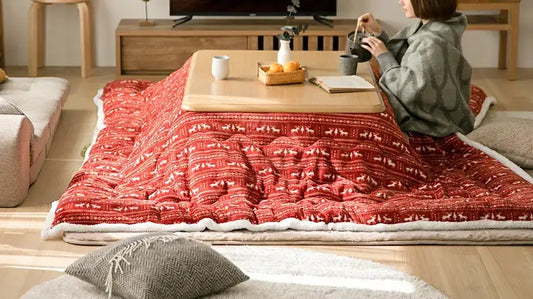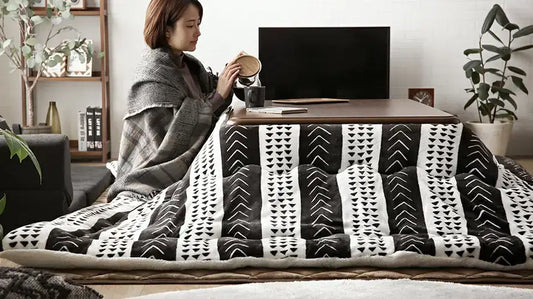Kotatsu Tables: Embracing Comfort and Connection
In the heart of Japanese culture, few objects embody the intertwining of tradition, practicality, and simple coziness as eloquently as the kotatsu. A modest wooden table layered with warm blankets and topped with a source of comfortable heat, it transforms a simple piece of furniture into a haven during Japan's chilly months. But the kotatsu is more than just a way to stay warm–it's a microcosm of Japanese life, a space for connection, relaxation, and the simple joys of daily existence.
Origins and Historical Evolution
The earliest roots of the kotatsu can be traced back to the Muromachi period (1336-1573), where it began as a charcoal brazier sunken into the floor and known as a "horigotatsu." This evolved into the more familiar "oki-gotatsu" – a portable structure with a heat source placed above a small table. As centuries unfurled, charcoal gave way to electricity in the 20th century, making the kotatsu a convenient and safer staple for a modernizing Japan.
The kotatsu's enduring presence in Japanese homes highlights an essential facet of Japanese design philosophy: the harmonious blending of form and function. It is a visually unassuming object, yet the brilliance lies in its unpretentious utility. This practicality, so deeply ingrained in Japanese aesthetics, stands as a testament to the beauty found within the ordinary.
The Essence of the Kotatsu Experience
Imagine stepping into a traditional Japanese home during the winter chill. You remove your shoes, the tatami mats cool beneath your feet. Yet, there beckons the kotatsu, its warm glow a beacon amidst the room. Slipping underneath the heavy futon that drapes over it, a blissful warmth envelopes you. It's a feeling akin to a gentle embrace.
The shared experience of gathering around the kotatsu fosters a sense of "wa" (harmony). Families convene around it for meals, conversations, and simple togetherness. It becomes a nexus where bonds are strengthened and time seems to slow down. In a culture known for its reserve, the kotatsu engenders an informal and relaxed space, one where hearts and minds can unwind.
The allure of the kotatsu rests in its multi-sensory appeal. The soft fabric of the futon brushes against the skin, the scent of roasted tea fills the air, and the gentle hum of the electric heater soothes the ears. It is a haven for all the senses, a testament to the Japanese attention to subtle detail and its emphasis on holistic experiences.
Practicality and Ingenuity
Beyond its emotional resonance, the kotatsu reveals the ingenuity of Japanese design. In a nation marked by a scarcity of expansive living spaces, the kotatsu embodies space efficiency. During the day, the futon can be folded and the table used for other purposes, reclaiming valuable floor space.
Furthermore, the kotatsu represents an ecologically responsible approach to heating. Rather than heating an entire house, it concentrates warmth within a small, designated area. This targeted warmth translates to a reduction in energy consumption, a philosophy woven deeply into Japanese design and resource management.
The Kotatsu in Modern Life
While an enduring symbol of tradition, the kotatsu has not been immune to contemporary influences. Modern kotatsu often integrate technological conveniences – adjustable heaters, timers, and various aesthetic customizations abound. Some homes even boast "horigotatsu," a modernized take on the sunken floor design popular centuries prior.
The kotatsu transcends the boundaries of the conventional home. Its warmth and inherent appeal have found a place within modern apartments, bustling coffee shops, and even some workplaces. This reflects not just its functionality, but its potent nostalgic value for many Japanese people – a tangible reminder of home, comfort, and cherished connections.
The Kotatsu as Social Symbol
The kotatsu transcends the realm of mere furniture, functioning as a powerful social symbol. The phrase "kotatsu de mikan" (みかん, or mandarin oranges, at the kotatsu) epitomizes a quintessential Japanese winter scene. The sweet fragrance of citrus fruits mingled with the warmth of the kotatsu paints a picture of familial warmth, an idyllic portrait deeply rooted in Japanese collective memory.
Beyond the immediate family, the kotatsu symbolizes hospitality. To welcome a guest into the warmth of the kotatsu is to extend an unspoken invitation into the inner circle. It's a gesture of inclusion and trust, a wordless offering of companionship and comfort.
However, true to the duality within Japanese culture, the kotatsu also carries a whiff of good-natured humor. The image of someone reluctant to emerge from the warm embrace of the kotatsu, often portrayed in a lighthearted manner in popular media, plays on the universal human inclination toward procrastination and simple pleasures. Yet, even this gentle mockery reinforces its status as a familiar and beloved part of the everyday Japanese experience.











